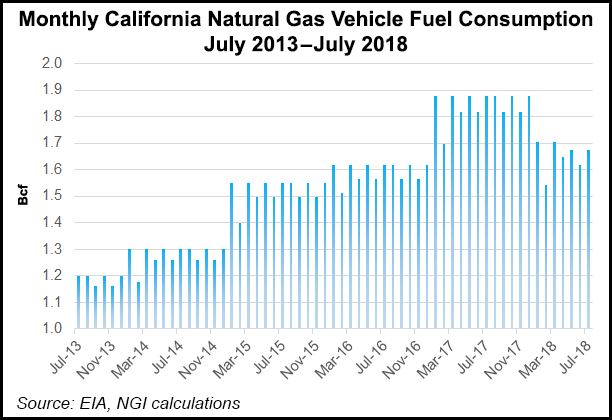NGI The Weekly Gas Market Report | Infrastructure | NGI All News Access
NGVs Still Have Role to Play in California Energy Policy
California is increasingly focused on zero-emissions transportation technologies such as electric vehicles and hydrogen fuel cells, but natural gas vehicles (NGV) are still in play with state and utility programs, particularly for the heavy-duty fleet sectors that carry goods and passengers.

Both the California Energy Commission (CEC) and California Air Resources Board (CARB) are continuing programs that fund the NGV sector. The CEC’s annual investment in natural gas transportation research is roughly $4 million annually, according to spokesperson Michael Ward.
CARB offers grant funding programs statewide through local air pollution control districts for the development of cleaner-than-required engines and equipment. Eligible vehicles include on-road trucks, school and transit buses, off-road equipment, marine vessels, locomotives, agricultural equipment, light-duty vehicle scrap and lawn mowers.
CARB works with the local districts to set guidelines and ensure the programs are reducing pollution in both the regions and in specific communities identified as being hit hardest by air pollution.
In one CEC program, two regional air pollution districts were each recently given $8 million in grants to fund compressed natural gas (CNG) development programs in the San Joaquin Valley and the four-county South Coast Air Quality Management District in Southern California.
The CEC also funds a second program that is run by the Institute of Transportation Studies at the University of California, Irvine, providing $21.8 million to the NGV Incentive Project. Ward said $18.3 million has been issued for vehicle purchases, $3.5 million is currently in a reserve fund and there are about $6.3 million in reservations on a waiting list for funding.
Last month, Gov. Jerry Brown also signed a bill into law to boost the use of NGV trucks by raising the maximum weight limits for zero-emission and near zero-emission vehicles. The limit is now 82,000 pounds instead of the previous 80,000-pound limit.
Nationally, Daniel Gage, president of Washington, DC-based NGVAmerica, said the entire transportation industry “is feeling pressure” from what he called the “electrify everything movement.” But Gage views the trend as a good opportunity for NGVs, particularly in the heavy-duty vehicle sector, to be promoted as the cleanest, most viable option available to help address climate change goals for greenhouse gas reductions.
“We try to point out to policymakers in California and other parts of the country that you can have some amazing air quality benefits today if you transition to NGVs now,” Gage told NGI.
“It’s not quite zero emissions, but it is pretty darn close, and you’re not going to get any closer with anything else today,” he said, adding that an electric vehicle with a range of 250 miles starts out life today with about a 68% higher carbon footprint than the gasoline equivalent.
Because of this advantage in the current market, Gage and his fellow NGV advocates urge state and federal policymakers to refrain from developing technology-specific mandates for alternative fuel vehicles.
CARB spokesperson Melanie Turner said her agency supports a variety of advanced clean technologies, including the NGV low nitrogen oxide (NOx) and near-zero emission vehicles.
Later this month, the CARB board is expected to approve a fiscal year 2018-2019 funding plan, including the $125 million Hybrid and Zero-Emission Truck and Bus Voucher incentive project (HVIP), which includes the NGV Cummins Westport 9-liter and 12-liter low-NOx engines.
“In fact, HVIP has provided funding for more than 1,000 low-NOx engines through last June 30,” Turner said. “And with the new funding, CARB expects to meet all market demand in the upcoming year.”
At the utility level, Sempra Energy’s Southern California Gas Co. (SoCalGas) has programs to help fleet operators purchase the near-zero emission NGV engines, helped fund studies of the smog-reducing impacts of the new engines and has opened new fueling stations in Southern California that provide CNG and renewable natural gas.
© 2024 Natural Gas Intelligence. All rights reserved.
ISSN © 1532-1231 | ISSN © 2577-9877 | ISSN © 1532-1266 |
